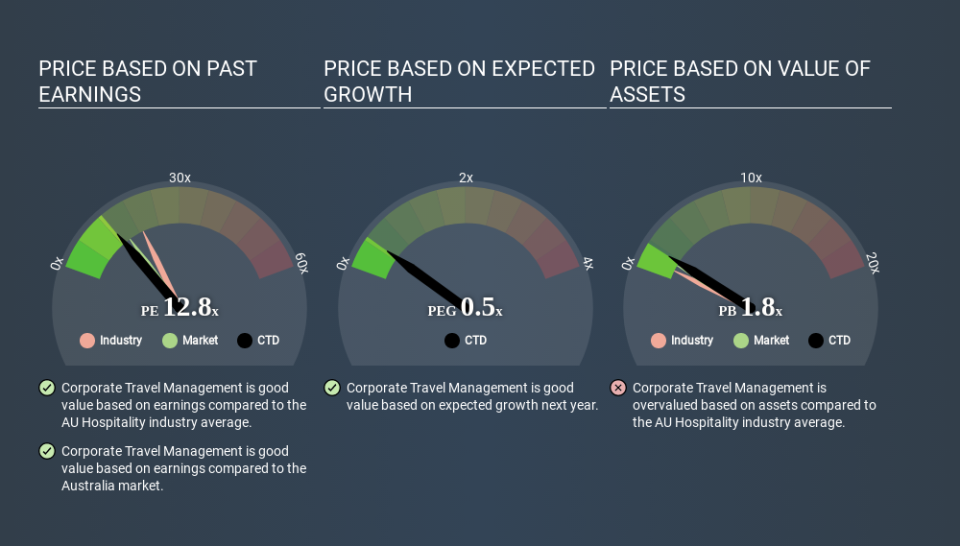What Is Corporate Travel Management's (ASX:CTD) P/E Ratio After Its Share Price Rocketed?

Those holding Corporate Travel Management (ASX:CTD) shares must be pleased that the share price has rebounded 102% in the last thirty days. But unfortunately, the stock is still down by 57% over a quarter. But that will do little to salve the savage burn caused by the 63% share price decline, over the last year.
All else being equal, a sharp share price increase should make a stock less attractive to potential investors. While the market sentiment towards a stock is very changeable, in the long run, the share price will tend to move in the same direction as earnings per share. The implication here is that deep value investors might steer clear when expectations of a company are too high. Perhaps the simplest way to get a read on investors' expectations of a business is to look at its Price to Earnings Ratio (PE Ratio). Investors have optimistic expectations of companies with higher P/E ratios, compared to companies with lower P/E ratios.
View our latest analysis for Corporate Travel Management
Does Corporate Travel Management Have A Relatively High Or Low P/E For Its Industry?
Corporate Travel Management's P/E of 12.84 indicates relatively low sentiment towards the stock. We can see in the image below that the average P/E (19.1) for companies in the hospitality industry is higher than Corporate Travel Management's P/E.
Its relatively low P/E ratio indicates that Corporate Travel Management shareholders think it will struggle to do as well as other companies in its industry classification. Many investors like to buy stocks when the market is pessimistic about their prospects. You should delve deeper. I like to check if company insiders have been buying or selling.
How Growth Rates Impact P/E Ratios
P/E ratios primarily reflect market expectations around earnings growth rates. When earnings grow, the 'E' increases, over time. That means even if the current P/E is high, it will reduce over time if the share price stays flat. So while a stock may look expensive based on past earnings, it could be cheap based on future earnings.
Corporate Travel Management saw earnings per share decrease by 6.9% last year. But over the longer term (5 years) earnings per share have increased by 27%.
Don't Forget: The P/E Does Not Account For Debt or Bank Deposits
Don't forget that the P/E ratio considers market capitalization. So it won't reflect the advantage of cash, or disadvantage of debt. Theoretically, a business can improve its earnings (and produce a lower P/E in the future) by investing in growth. That means taking on debt (or spending its cash).
While growth expenditure doesn't always pay off, the point is that it is a good option to have; but one that the P/E ratio ignores.
How Does Corporate Travel Management's Debt Impact Its P/E Ratio?
Corporate Travel Management has net cash of AU$65m. That should lead to a higher P/E than if it did have debt, because its strong balance sheets gives it more options.
The Bottom Line On Corporate Travel Management's P/E Ratio
Corporate Travel Management trades on a P/E ratio of 12.8, which is below the AU market average of 14.7. The recent drop in earnings per share would make investors cautious, but the net cash position means the company has time to improve: if so, the low P/E could be an opportunity. What we know for sure is that investors have become much more excited about Corporate Travel Management recently, since they have pushed its P/E ratio from 6.4 to 12.8 over the last month. For those who prefer to invest with the flow of momentum, that might mean it's time to put the stock on a watchlist, or research it. But the contrarian may see it as a missed opportunity.
When the market is wrong about a stock, it gives savvy investors an opportunity. As value investor Benjamin Graham famously said, 'In the short run, the market is a voting machine but in the long run, it is a weighing machine. So this free visual report on analyst forecasts could hold the key to an excellent investment decision.
You might be able to find a better buy than Corporate Travel Management. If you want a selection of possible winners, check out this free list of interesting companies that trade on a P/E below 20 (but have proven they can grow earnings).
If you spot an error that warrants correction, please contact the editor at editorial-team@simplywallst.com. This article by Simply Wall St is general in nature. It does not constitute a recommendation to buy or sell any stock, and does not take account of your objectives, or your financial situation. Simply Wall St has no position in the stocks mentioned.
We aim to bring you long-term focused research analysis driven by fundamental data. Note that our analysis may not factor in the latest price-sensitive company announcements or qualitative material. Thank you for reading.

